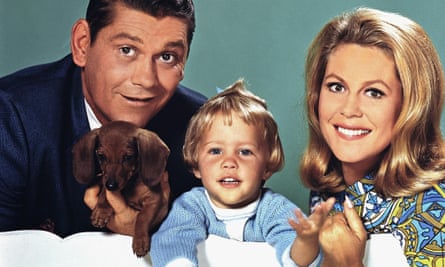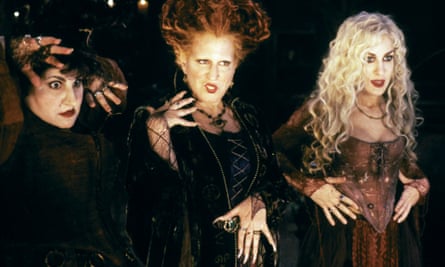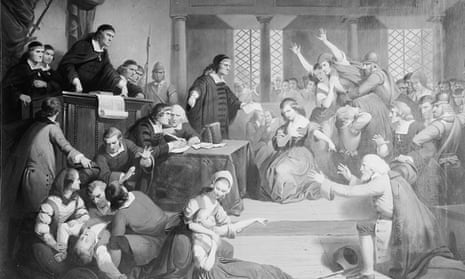It’s Halloween, and witches are naturally on the mind as thousands of small children prepare to don pointed hats and black capes in an attempt to scare candy from their neighbors.
But one town in America has a very real connection to “witches”: Salem, Massachusetts, where 20 people – nearly all of them women – were executed for practicing witchcraft in 1692. In the quiet cobblestoned town, the Salem Witch Museum serves today as a solemn reminder of the city’s sordid past.
This week the Guardian caught up with Stacey Tilney, the director of communications at the town’s Salem Witch Museum, and spoke with her about the history of the museum, witches in pop culture and – most important of all – the 1993 film Hocus Pocus.
Tell me about the background of the museum and how it came to be.
It begins with the building the museum is housed in, which is an old brownstone church from the 1840s. It stopped being a church during World War II and was ready to be razed by the 1970s, unless someone could take over the building. At that time, it was difficult to find out information about the Salem witch trials. There wasn’t a place to go for research. It was the combination of the need to preserve the building, along with a resurgence of interest in witches that led to the founding of the museum in 1972.
What drew you to work at the museum?
I came to Salem about 10 years ago and fell madly in love with the community. My love for Salem led me to become a volunteer at the museum two years ago, and next thing you know, here I am, telling the fascinating story of the Salem witch trials. I learn something every day.
When visitors come to the museum, do you think they’re more interested in the history of the Salem witch trials, or are they more interested in the pop-cultural aspect of witches?
I don’t know that one or the other gets people here, but the fact is that the two overlie each other. Initially, the TV show Bewitched contributed to the resurgence of interest I mentioned. People don’t only come for the general iconography of witches, but how it overlaps with the true, and rather macabre, history of Salem. While we know it’s a myth, three hundred short years ago, people really believed that these women were flying around on broomsticks.

Do you experience a surge in visitors around pop-cultural peaks, like American Horror Story: Coven?
It can only help. This year, WGN ran a program called Salem, which got a lot of press. Plus, later this year, Meryl Streep is starring as a witch in Into the Woods. Really, it’s the year of the witches.
Part of the museum features the evolving perception of witches and “witch-hunts” over the years, such as Senator Joseph McCarthy’s witch-hunts of the 1950s. Could you speak to these connections?
We believe that the legacy of the witch trials continues in an allegorical way. Whenever we are afraid as a community of a particular issue ailing us, we find and persecute a group of people, so we can assuage our own fears. The idea behind the Salem witch trials was that they tapped into a communal anxiety when people noticed others acting outside of their expectations. They began to persecute them in hopes that they would drive out the devil, to borrow from their own vernacular.
During the McCarthy era, communism was set up as the villain. Anyone who had ever attended a meeting or picked up a pamphlet or entertained the idea of becoming a communist would later be called out and asked to name others. The ideal behind McCarthy’s witch-hunt was to assuage our fear of communism taking over the lives of Americans, and by scapegoating and getting rid of certain people, it was believed to be a way of re-embracing the American ideal.
Jumping forward to the present, do you see any correlation between the way we as America are treating the nurse from Maine in regards to the Ebola scare?
I don’t know if I would call that a witch-hunt, but I think that it’s our human inclination that whenever we’re worried to try and put a name and a face on the issue, and that by getting rid of that, it is a symbolic way of controlling our fear. I don’t think that people actually think this nurse is going to be the linchpin, but somehow psychologically we feel that by putting her under quarantine, we’re controlling our own fears.
What’s one thing you would like visitors to take away from the museum?
How by oversimplifying the way we talk about diversity, we oversimplify people. We make assumptions based off the way someone presents themselves. In 1692, this was determined by how you carried yourself or if you argued with your husband. The idea remainds the same: if you don’t subscribe to societal norms, then you’re often considered an outcast or you’re scapegoated. We should move towards seeing people for the individuals they are and appreciating our differences.

One final question: are you and the staff at the museum fans of the movie Hocus Pocus, which is set in a version of modern-day Salem and features a fictionalised version of the museum?
We might be the biggest fans of Hocus Pocus ever. We have a couple of Hocus Pocus nerds here, and we even do a trivia night.

Comments (…)
Sign in or create your Guardian account to join the discussion